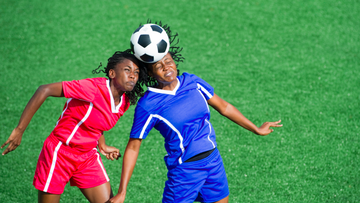Why a Soccer Concussion Headband Still Matters for “Mild” Hits to the Head
Jun 6, 2022
Minor hits to the head - a.k.a subconcussive hits - can damage the brain more than previously thought. Research has shown that Chronic Traumatic Encephalopathy (CTE) stems from thousands of small bumps to the head instead of concussions.
These findings highlight the importance of taking even “small” head impacts seriously and never having a carefree or lackadaisical attitude about milder head trauma. This post will look at this research and why the findings make wearing a concussion headband vital.
Research Suggests Subconcussive Hits Lead to CTE, Not Concussions
A study published in the research journal Brain, found that the hardest hits weren’t necessarily the ones that caused CTE. The researchers found that many as 20% of those diagnosed with this terrible, progressively fatal disorder have never sustained a concussion.
The researchers examined four postmortem brains of teenage athletes who suffered repeated head impacts, 1, 2, 10, and 128 days before death. There was a wide range of post-traumatic signs, one of which exhibited early signs of CTE and two that showed abnormal amounts of tau protein (more on this below).
The researchers conducted mouse model tests using repeat closed-head impact and blast exposure (concussive) injury mechanisms. Their goal was to understand their causal relationship to the development of CTE.
Using a specialized brain scan called dynamic contrast-enhanced magnetic resonance imaging (DCE-MRI), researchers found striking similarities between the injured teens and mice in the repeat closed-head impact group. The blast exposure (concussion) group did not show any signs of CTE, suggesting that repetitive minor impacts may cause CTE-related pathology instead of concussions.
These results line up with other studies conducted in recent years.
A Look at Subconcussive Hits
A 2018 research study carried out by the University of British Columbia, researchers found that players who headed the ball more than 40 times had higher brain-degenerating proteins. That is a key reminder that these players didn’t suffer concussions, just repeated head impacts.
The researchers identified two proteins, tau and light neurofilament (NF-L). These proteins are involved in developing neurodegenerative disorders such as dementia, Alzheimer’s disease, and multiple sclerosis.
The researchers compared the levels of these proteins on the day players headed the ball versus the days they didn’t. Levels of these brain degenerating proteins were significantly higher on the days they headed the ball.
Even more interestingly (and concerningly), the players who headed the ball repeatedly showed increased levels of these proteins a month after afterward. They were also more likely to report cognitive effects such as headaches, dizziness, and confusion.
Soccer Concussion Takeaways from These Studies
If you remember the study we mentioned above, two out of four brains studied demonstrated elevated levels of tau protein as well. That isn’t to say that concussions can’t elevate these proteins either, since other research has shown that even one head injury can lead to tau presentation. But it seems that the repetitive minor hits are more likely to lead to CTE.
These findings correlate with the fate of many soccer players who died early. The likes of Jeff Astle and Brazilian star Bellini were diagnosed posthumously with CTE, and over 250 players have suffered from neurodegenerative in their later years. The common link? Many of them were prolific headers or frequently sustaining hits to the head.
Wearing a Soccer Concussion Headband May Reduce Repetitive Trauma
Ultimately, these findings show the importance of soccer concussion prevention. It’s not something to take likely. Realistically, most head impacts, whether they’re mild or severe, will not result in long-term disability or injury. Nevertheless, there is an elevated risk of long-term effects for some players. Facts age, gender, and genetics may increase their risk, making head injury prevention a must.
The first line of defense against head impacts is a soccer concussion headband. They can’t prevent all concussions and head impacts, but they may reduce the effects of severe ones and offer excellent protection against repetitive hits. The material in soccer headgear acts as a cushion, absorbing the shock of impact and redirecting the force from the skull.
Our Storelli ExoShield Head Gaurd demonstrated the ability to reduce concussions by 84% in a Virginia Tech Study. Keep in mind that those were hard impacts. Subconcussive hits are much less impactful, so wearing a soccer concussion headband could further protect the brain from repetitive hits.
A Mild Hit is Nothing to Scoff At
As more research emerges, it’s becoming clear that mild hits to the head can have serious consequences in the future. But even if the findings are concerning, they’re more enlightening and empowering.
With this knowledge, coaches, players, and parents can take more precautions to stay safe, especially when heading the ball. Wearing a soccer concussion headband is a great place to start. Practicing proper header technique and visual awareness can also help players avoid too many impacts.
In soccer, as it is with many sports, fewer hits to the head in one’s prime can mean fewer long-term problems later in life.
Are you looking for concussion headgear to reduce the risk of brain injury? Take a look at our ExoShield headguard and learn how it can help.

